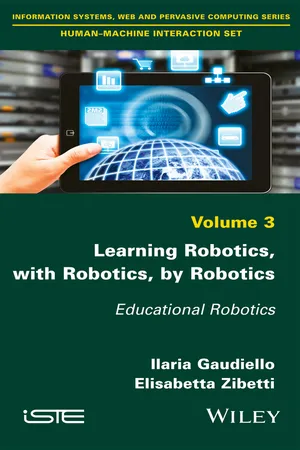
Learning Robotics, with Robotics, by Robotics
Educational Robotics
- English
- ePUB (mobile friendly)
- Available on iOS & Android
Learning Robotics, with Robotics, by Robotics
Educational Robotics
About this book
The relationship between technological and pedagogical innovation has recently created a new field of research at the crossroads between Psychology, Educational Sciences and Artificial Intelligence: Educational Robotics (ER).
Through analysis of the achievable educational goals based on the technological status and specific learning modes of different types of robots, it is possible to define three pedagogical paradigms: learning robotics, learning with robotics, and learning by robotics.
In this book we address these three paradigms through three themes: human representations of robots, the acceptance and trust shown when interacting with a humanoid, and learning favored by the development and programming of robots in an educational context. These themes allow the authors to fully explore, define and delimit this novel field of research for future application in educational and social contexts.
Finally, the book discusses contributions and limitations which have emerged from different methodologies of research, potential educational applications, and concepts of human–robot interaction for the development of the above paradigms.
Frequently asked questions
- Essential is ideal for learners and professionals who enjoy exploring a wide range of subjects. Access the Essential Library with 800,000+ trusted titles and best-sellers across business, personal growth, and the humanities. Includes unlimited reading time and Standard Read Aloud voice.
- Complete: Perfect for advanced learners and researchers needing full, unrestricted access. Unlock 1.4M+ books across hundreds of subjects, including academic and specialized titles. The Complete Plan also includes advanced features like Premium Read Aloud and Research Assistant.
Please note we cannot support devices running on iOS 13 and Android 7 or earlier. Learn more about using the app.
Information
1
Learning Robotics: Users’ Representation of Robots
1.1. Introduction: the ontological and pedagogical status of robots
“Among all human artifacts, perhaps robots share the most in common with their maker. Like computers, and in fact because they are controlled by computers, they can process huge amounts of information. Like powered equipment, they can manipulate their environment and move within it. And like dolls, mannequins and other effigies, they can resemble us – either abstractly or down to the dimples of our cheeks. Nevertheless, the differences between machine and maker are profound. Metabolism, life span, sexual reproduction, ancestry, culture and consciousness for now distinguish us from robots. Thus, the similarities and differences between us and them circumscribe a chasm that is at once narrow and deep”.
1.2. What do we mean by robot representation?
Table of contents
- Cover
- Table of Contents
- Title
- Copyright
- Foreword
- Preface
- Introduction
- 1 Learning Robotics: Users’ Representation of Robots
- 2 Learning with Robotics: Functional and Social Acceptance of Robots
- 3 Learning by Robotics: The Impact of Educational Robots on Learning
- Conclusion and Perspectives
- Appendices
- Bibliography
- Index
- End User License Agreement